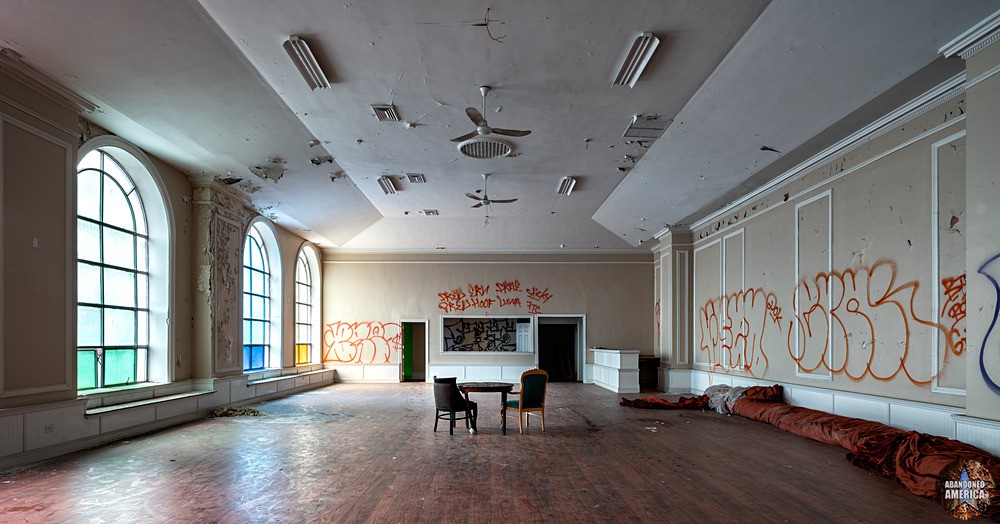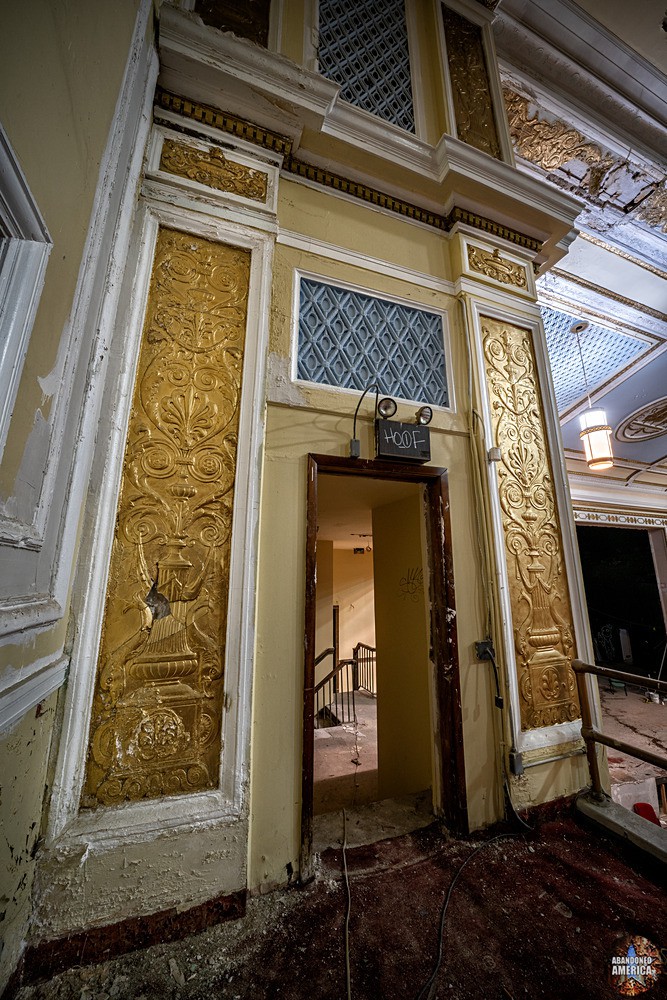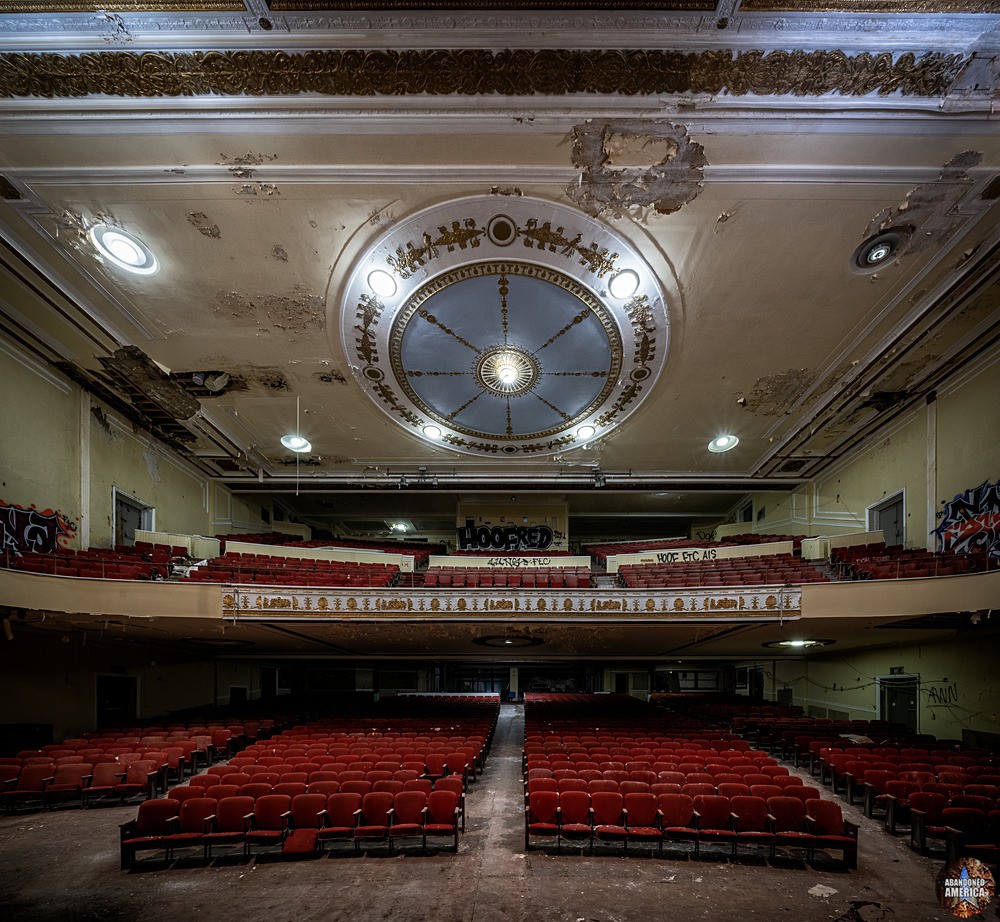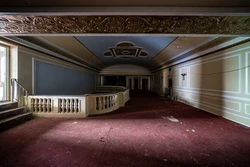The Philadelphia landmark known as the Logan Theater has had many various incarnations; after lying empty for two decades, it appears that a new design may be in store.
The Logan Theater was designed by architects Hoffman & Hernon and constructed in 1924 by the Stanley Cooper Company of America for a cost of $1 million. The Stanley Company was established in 1916 by Stanley and Jules Mastbaum, brothers, and was headquartered in Philadelphia. The corporation was valued at $15,000,000 and operated 24 theaters in the area by 1920.
The Logan Theater was designed in the Adamesque style, which made use of pastel colors, painted decorations, and Roman ornamental flourishes as neoclassical accents. These decorations in the Logan included mythical creature motifs and a ship-themed mural in the lobby. The Common Law, starring Corinne Griffith, one of the most well-known and stunning actresses of the silent film era, opened the theater, which held 1,894 seats. The Kimball pipe organ and the Loganians orchestra provided musical accompaniment for the performance. The Waltz Studio, a ballroom for parties, was located on the second level.

The ballroom on the second floor of the Logan Theater was originally called the Waltz Studio.
Following the Logan’s transition to talkies, the events became rather typical theater entertainment. The Logan Orchestra performed there on tour, popular culinary lessons were offered there in the 1960s, and the Miss Logan Beauty Contest was hosted there. Later on, boxing fights were shown on television in theaters. Cleveland Williams and Muhammad Ali’s 1966 heavyweight championship bout is arguably the most well-known of them.
Other strange incidents included a man who collapsed and died in the lobby in 1945, a purse that was stolen outside by a “footpad” in 1951, and an attempted robbery that ended in failure when the would-be robbers were unable to access the safe and had to make do with breaking into the vending machines to steal candy and cigarettes. The oddest story I like the best is probably about the Oscar Mayer Weinermobile and its mascot Little Oscar, who was 13 hot dogs tall, visiting the theater in the 1950s and 1960s. At one of these gatherings, there was a yo-yo competition, and a boy was doing the loop-de-loop when he unintentionally struck Little Oscar in the head with his yo-yo.The Logan’s final performance took place on January 20, 1973. That day’s selections included the now-obscure cult spaghetti western Blindman, starring Ringo Starr, and the blaxploitation film Trouble Man, which is regarded as one of the 50 greatest blaxploitation films of all time as well as one of the 50 worst. The film is about “a hard-edged private investigator who tends to take justice into his own hands.” In either case, the Deliverance Evangelical Church purchased the theater from RKO Stanley Warner in May 1973.

Despite damage from vandalism, the decorative elements of the Logan Theater remain beautiful.
For almost twenty years, Deliverance Evangelistic Church was housed at the theater. There were 7,000 people in their church, according to a 1985 Philadelphia Inquirer article, and standing room only was used for services. Founded in 1961, Deliverance Evangelistic Church worked to provide services to the neighborhood’s economically marginalized residents. The neighborhood’s population had decreased by 25% between 1970 and 1980, and residents were forced to travel to other parts of the city to access services like banks and shoe stores. Deliverance Evangelistic Church’s membership had grown to 9,000 by 1990. In 1992, the church decided to relocate 40 blocks south to a new facility in the former Connie Mack stadium, where they are still located today.Dr. Owen Williamson bought the Logan Theater in 2005 after it had been empty for some time. Dr. Williamson, a Jamaican immigrant, was employed as a staff physician at Episcopal Hospital and attended Temple University’s Lewis Katz School of Medicine.
Despite jeers from coworkers about going to work in “Vietnam,” he started an office in North Philadelphia because he was deeply committed to helping the “medically abandoned community,” where there was only one doctor for every 3,400 residents. Reopening the theater as a music and entertainment hub for the community, Dr. Williamson intended to rename it Claretildaville in honor of his late wife Claretilda.He repaired leaks in the roof and repainted, but in the end, the job was too large and costly to finish. I’ve heard that Dr. Williamson passed away, leaving The Logan Theater and his practice empty, but I’m not sure if this is accurate or when.
I made a visit to The Logan Theater around this time. The lights were still on and vandals had begun spray-painting graffiti over Dr. Williamson’s new paint job. Seeing the amount of work he had done to restore the building in memory of his wife, only to have someone try to demolish it at the first chance, was sad. If Dr. Williamson had been successful in reviving the theater, it would have been a bright spot in a neighborhood that could have used the economic and cultural investment. The neighborhood is in dire need of reliable enterprises.

Even in poor lighting and covered with graffiti, the Logan Theater remains in good condition and could be successful if reopened.
Reopening The Logan Theater as a concert venue is currently the subject of fresh plans. The building will be renamed the Cicely Tyson Music Theater in honor of the late actress Cicely Tyson, who was well-known for her roles in numerous films, including Sounder, Fried Green Tomatoes, The Help, and Diary of a Mad Black Woman. The building is being organized by the nonprofit organization The American Emerald Awards Foundation. The Logan Theater’s 100th anniversary is in February 2023. Chief Operating Officer Damariz Winborne hopes that the theater will become Philadelphia’s Apollo Theater and contribute to the development of the neighborhood as a Black Broadway by holding a soft opening around that time.
It’s difficult to say whether the restoration effort is still underway as of June 2023 because there are no updates on the status and the website is no longer operational, but I sincerely hope it is. North Philadelphia needs and deserves the economic boost that arts and entertainment venues can provide, as they can stimulate the expansion of local businesses such as restaurants. It would be encouraging to see Dr. Williamson’s dream come true, even if it isn’t called Claretildaville. In fact, once the building is finished, a mural featuring well-known Black musicians and performers will be painted there, showing Dr. Williamson and his wife Claretilda together for the first time.
